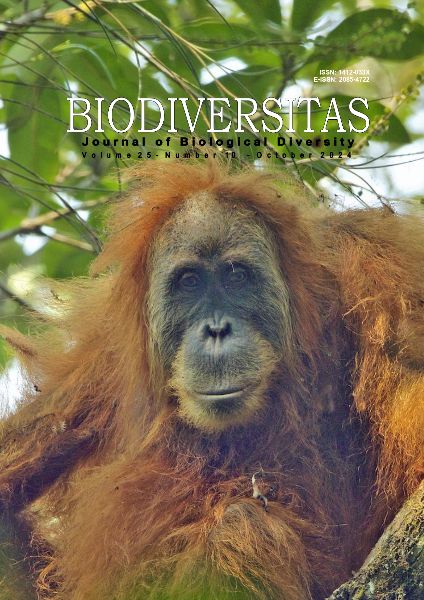Fungi biodiversity during biorefinery of oil palm waste
##plugins.themes.bootstrap3.article.main##
Abstract
Abstract. Kesumaningwati R, Nugroho RA, Darma S, Fahrunsyah, Candra KP, Hardi EH, Darma S. 2024. Fungi biodiversity during biorefinery of oil palm waste. Biodiversitas 25: 3596-3607. The rapidly growing palm oil industry faces significant waste management challenges that necessitate improvements in the biorefinery processes. This study aimed to determine the diversity of fungi during the biorefinery process of oil palm waste. An optimization study was conducted utilizing Response Surface Methodology (RSM) based on the Box-Behnken experimental design. We examined four factors: the bioactivator, Oil Palm Empty Fruit Bunches (OPEFB), Palm Oil Mill Effluent (POME), and the composting time in a 3 kg biorefinery system. The results revealed 16 and 21 types of fungi at the genus and species levels, respectively. The biodiversity indices, specifically the Simpson (D) and Shannon (H’), reflected shifts in fungal diversity throughout the biorefinery process. The indices at the genus level peaked in the middle of the biorefinery (day 24.5, indicating the highest diversity) with low (D=0.085-0.154) and medium (H’=1.992-2.671) values. On day 7, the compost temperature was 34.98°C, declining to 29.50 and 28.82°C on days 24.5 and 42, respectively. Aspergillaceae and Rhizopodaceae were the two dominant families involved in the composting process, with Aspergillus, Fusarium, and Rhizopus being the predominant genera. At the species level, Aspergillus flavus Link, Aspergillus fumigatus Fresen., Aspergillus niger Tiegh., and Rhizopus sp. were fully engaged during the composting process. OPEFB concentration and composting time significantly influenced the compost C/N ratio, as did the interaction between composting time and the other two factors (EM4 volume and OPEFB). The optimal composting conditions were determined to be: EM4 volume of 15 mL, OPEFB at 30.895%, POME at 59.989%, and a composting time of seven days. The resulting compost exhibited a C/N ratio of 19.084, moisture content of 49.999%, C-organic content of 72.595%, N-total of 3.791%, and K-total of 5.867%, with a desirability of 77.6%.
##plugins.themes.bootstrap3.article.details##
Most read articles by the same author(s)
- ESTI HANDAYANI HARDI, RUDY AGUNG NUGROHO, GINA SAPTIANI, RIA SARINAH, MAULINA AGRIANDINI, MIRA MAWARDI, Identification of potentially pathogenic bacteria from tilapia (Oreochromis niloticus) and channel catfish (Clarias batrachus) culture in Samarinda, East Kalimantan, Indonesia , Biodiversitas Journal of Biological Diversity: Vol. 19 No. 2 (2018)
- RUDIANTO AMIRTA, SYAFFIYA ISNU NAFITRI, RETNO WULANDARI, YULIANSYAH YULIANSYAH, WIWIN SUWINARTI, KRISHNA PURNAWAN CANDRA, TAKASHI WATANABE, Comparative characterization of Macaranga species collected from secondary forests in East Kalimantan for biorefinery of unutilized fast growing wood , Biodiversitas Journal of Biological Diversity: Vol. 17 No. 1 (2016)
- GINA SAPTIANI, CATUR AGUS PEBRIANTO, AGUSTINA AGUSTINA, ESTI HANDAYANI HARDI, FIKRI ARDHANI, Short Communication: Diversity and prevalence of ectoparasites associated with cultured fish from coal ponds in East Kalimantan, Indonesia , Biodiversitas Journal of Biological Diversity: Vol. 18 No. 2 (2017)
- FANGGI, ESTI HANDAYANI HARDI, ANDI NIKHLANI, ANTON PANJI MAHENDRA, NOVITA, FITRI NOERHIDAYANTI, Physical, chemical, and biological characteristics of crab (Scylla spp.) from East Kalimantan, Indonesia , Biodiversitas Journal of Biological Diversity: Vol. 24 No. 9 (2023)
- MIRA MAWARDI, JAELANI JAELANI, ZAKKI ZAINUN, YUANI MUNDAYANA, BAIRD SAM CHILORA, ESTI HANDAYANI HARDI, Identification and characterization of Edwardsiella ictaluri from diseased Pangasius pangasius, cultured in Cirata Lake, Indonesia , Biodiversitas Journal of Biological Diversity: Vol. 19 No. 3 (2018)
- NURUL PUSPITA PALUPI, ESTI HANDAYANI HARDI, FAHRUNSYAH, DWI ERMAWATI RAHAYU, RUDY AGUNG NUGROHO, SURYA DARMA, SURIA DARMA IDRIS, Spatial distribution of paddy field’s heavy metals diversity contamination in Samarinda using remote sensing imagery , Biodiversitas Journal of Biological Diversity: Vol. 24 No. 12 (2023)


 https://orcid.org/0000-0001-9006-7329
https://orcid.org/0000-0001-9006-7329